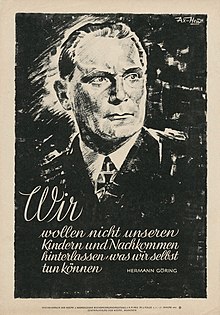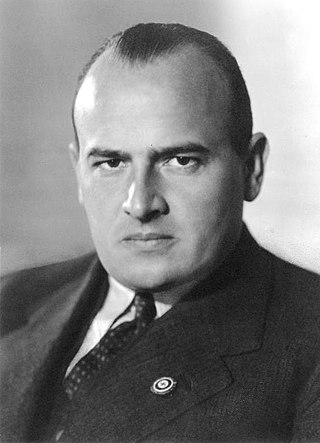
Hans Michael Frank was a German politician, war criminal and lawyer who served as head of the General Government in German-occupied Poland during the Second World War.
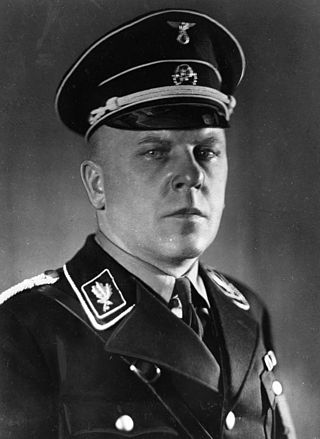
Max Amann was a high-ranking member of the Nazi Party, a German politician, businessman and art collector, including of looted art. He was the first business manager of the Nazi Party and later became the head of Eher Verlag, the official Nazi Party publishing house. He was also the Reichsleiter for the press. After the war ended, Amann was arrested by U.S. military occupation authorities. A denazification court deemed him a Hauptschuldiger. Amann was sentenced to ten years in a labour camp, stripped of his property, pension rights, and virtually all of his fortune.

Omar Amin was an Alter Kämpfer and an honorary Sturmbannführer in the Waffen-SS in Nazi Germany, where he was also a professor known for his anti-Jewish polemics. He was one of the most important ideologues of the Third Reich, serving as a high-ranking propaganda ministry official. He later served in the Egyptian Information Department, as well as an advisor to Gamal Abdel Nasser. He published for Goebbels, in Peron's Argentina and for Nasser's Egypt. He converted to Islam, and changed his name to Omar Amin.
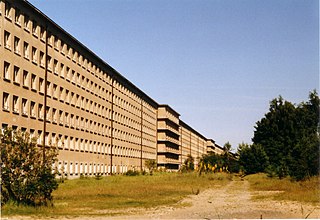
Clemens Klotz was one of Adolf Hitler's architects.

The Nazi Party/Foreign Organization was a branch of the Nazi Party and the 43rd and only non-territorial Gau ("region") of the Party. In German, the organization is referred to as NSDAP/AO, "AO" being the abbreviation of the German compound word Auslands-Organisation. Although Auslands-Organisation would be correctly written as one word, the Nazis chose an obsolete spelling with a hyphen.

The propaganda used by the German Nazi Party in the years leading up to and during Adolf Hitler's dictatorship of Germany from 1933 to 1945 was a crucial instrument for acquiring and maintaining power, and for the implementation of Nazi policies.

Das Reich was a weekly newspaper founded by Joseph Goebbels, the propaganda minister of Nazi Germany, in May 1940. It was published by Deutscher Verlag.
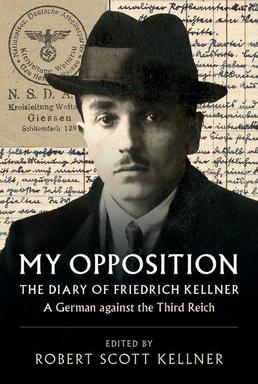
My Opposition is a diary secretly written by the German social democrat Friedrich Kellner (1885–1970) during World War II to describe life under Nazi Germany and to expose the propaganda and the crimes of the Nazi dictatorship. Comprising ten notebooks, it is considered by leading historians as "an important piece of historical literature." The editors of the German magazine Der Spiegel called it "an image of Nazi Germany that has never existed before in such a vivid, concise and challenging form." Kellner began his 861-page diary on September 1, 1939, and wrote his last entry on May 17, 1945.
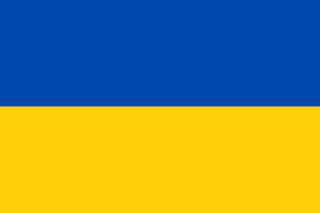
The Free State of Brunswick was a state of the German Reich in the time of the Weimar Republic. It was formed after the abolition of the Duchy of Brunswick in the course of the German Revolution of 1918–19. Its capital was Braunschweig (Brunswick). In 1933 it was de facto abolished by Nazi Germany. The free state was disestablished after the Second World War in 1946.

The Brown House was the name given to the Munich mansion located between the Karolinenplatz and Königsplatz, known before as the Palais Barlow, which was purchased in 1930 for the Nazis. They converted the structure into the headquarters of the National Socialist German Workers' Party. Its name comes from early Nazi Party uniforms, which were brown. Many leading Nazis, including Adolf Hitler, maintained offices there throughout the party's existence. It was destroyed by Allied bombing raids during World War II.
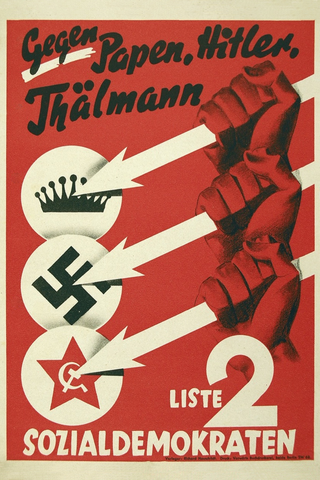
The Iron Front was a German paramilitary organization in the Weimar Republic which consisted of social democrats, trade unionists, and democratic socialists. Its main goal was to defend democratic socialism and liberal democracy against what was viewed as totalitarian ideologies on the far-right and far-left. The Iron Front chiefly opposed the Sturmabteilung (SA) wing of the Nazi Party and the Antifaschistische Aktion wing of the Communist Party of Germany. Formally independent, it was intimately associated with the Social Democratic Party of Germany (SPD). The Three Arrows, originally designed for the Iron Front, became a well-known social democratic symbol representing resistance against monarchism, Nazism, and Marxism-Leninism during the parliamentary elections in November 1932. The Three Arrows were later adopted by the SPD itself.

Albert Norden was a German communist politician.
Karl-Günther Heimsoth, also known as Karl-Guenter Heimsoth, was a German physician, polygraph, and politician. Heimsoth was a member of the Nazi Party and later the Communist Party of Germany.
Lying press is a pejorative and disparaging political term used largely for the printed press and the mass media at large. It is used as an essential part of propaganda and is thus usually dishonest or at least not based on careful research.

The Three Arrows is a social democratic political symbol associated with the Social Democratic Party of Germany (SPD), used in the late history of the Weimar Republic. First conceived for the SPD-dominated Iron Front as a symbol of the social democratic resistance against Nazism in 1932, it became an official symbol of the Party during the November 1932 German federal election, representing their opposition towards monarchism, Nazism, and communism.

During a speech at the Reichstag on 30 January 1939, Adolf Hitler threatened "the annihilation of the Jewish race in Europe" in the event of war:
If international finance Jewry inside and outside Europe should succeed in plunging the nations once more into a world war, the result will be not the Bolshevization of the earth and thereby the victory of Jewry, but the annihilation of the Jewish race in Europe.
Wolfgang Diewerge was a Nazi propagandist in Joseph Goebbels' Reich Ministry of Popular Enlightenment and Propaganda. His special field was anti-Semitic public relations, especially in connection with trials abroad, which could be exploited for propaganda purposes. He also played an essential role in the preparation of a show trial against Herschel Grynszpan, whose assassination attempt on a German embassy employee in Paris had been used by the Nazis as a trigger for the November pogroms in 1938. In 1941, his pamphlets on the so-called Kaufman Plan and the Soviet Union were published in print runs of millions. After the war, Diewerge managed to re-enter politics via the FDP North Rhine-Westphalia. However, the intervention of the British occupation authorities and a commission of the FDP's Federal Executive Committee put an abrupt end to this intermezzo. In 1966 Diewerge was convicted of perjury for his statements made under oath about the Grynszpan trial planned by the National Socialists. After all, he was involved in the Flick donations affair as managing director of two associations.

Parole der Woche was a wall newspaper published by the Reichspropagandaleitung der NSDAP from 1937 to 1943. Historian Jeffrey Herf describes Parole der Woche as "the most ubiquitous and intrusive aspect of Nazism's visual offensive ... no form of Nazi visual propaganda made so crucial a contribution to the regime's presentation of ongoing events".
Angelika Schaser is a German historian.
